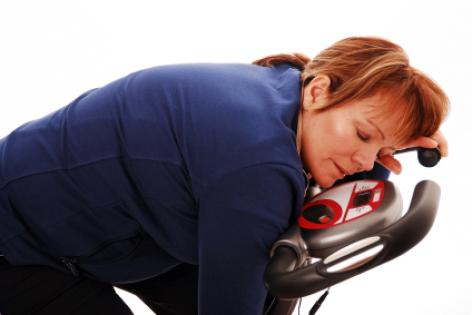Do you cut short your time on a run or a walk, or at the gym or yoga, because you’re feeling tired? Or do you not go at all?
Sometimes this sense of tiredness can be about perceptions more than anything so it’s important to make exercise seem easier so you get more enjoyment out of it. The act of exercising can also make you feel less fatigued and more energise. Here are some fatigue-fighting tips that might help.
1. Eat carbohydrates
Low-carb diets are popular, but they aren’t ideal for exercise as Kerryn Boogaard set out in her recent article here. Having insufficient carbohydrates in your system keeps your body from getting the maximum benefit from strength-based activities. Low-carb eaters can also experience increased levels of fatigue from exercise. If you plan to work out and it has been more than three hours since you last ate, fuel up. A banana is a good choice, but make sure you stay away from refined, simple carbohydrates such as white bread.
2. Drink more water
When you’re dehydrated, your cardiovascular system feels the effects, weakening the flow of blood to your muscles and decreasing your energy. Replenish your fluids before, during and after exercise, and increase the amount if you sweat heavily or the air temperature is high.
3. Keep a diary
Tracking your activity and success will help motivate you, just as a calorie log helps when you’re dieting. Consider recording such things as your waist circumference, the total amount of time you exercise, the distance covered during cardiovascular training and the number of reps, sets and kilos lifted during strength training. There are so many good Apps that help to keep track of this, so take a look around the App store for a free one.
4. Find a partner
Pairing up can push you to do more than you would alone and make you more accountable – especially if they’re in better shape than you! A 2010 study in the Journal of Social Sciences found that when men and women cycled with another cyclist who was more highly trained, they exercised harder even when instructed to keep a moderate pace. If a person trained with a cyclist below his or her fitness level, performance declined. If you don’t have a buddy available, try using some of the newer exercise machines that offer virtual training partners and other interactive features.
5. Listen to music
Music makes exercise more fun and, like a training partner, it can distract you and reduce your perception of effort. But it also stimulates people’s innate tendency to move in time with sound! To encourage yourself to work out longer, choose songs you really enjoy – make a special playlist. If you go to a gym, and don’t like the music, make sure you tell them. If they’re focussed on their clients, they will do what they can to get better music for you.
6. Exercise in the afternoon
I’m an advocate of morning exercise for most people, but if your joints have trouble waking up, you might find it better to exercise later in the day when you’re warmed-up. But try not to train within 2-3 hours of bedtime. Body temperature rises during exercise and can take several hours to drop, which can sleep – and make you feel tired! By the way, exercise at any time of day is better than no exercise!
7. Mind your breathing
For weight training, exhale during the resistance (‘lifting’) phase of the exercise and inhale as you return to the starting position. Never hold your breath. For cardiovascular training, try to breathe from your belly or chest, and not while lifting your shoulders.
8. Mix it up
Repetitive training can cause boredom and fatigue. If you are a member of a fitness club, use a different cardio machine on every visit, and change your weightlifting program every four weeks to work different muscle groups. If needed, consult a personal trainer.



















__small.png)










